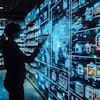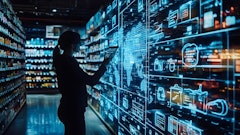
In today’s global businesses, whoever heard of a procurement organization of one?
And yet, leading procurement organizations are beginning to envision themselves as being:
- One with the business, with an embedded, strategic team.
- One with an expanded ecosystem of suppliers.
- One with re-imagined processes.
What does that mean for the future of procurement?
The Future of Procurement: Smaller Organizations that Pack a Bigger Punch
In the coming years, Accenture Strategy research suggests that, rather than focusing exclusively on cost reduction and savings, the value procurement delivers, and how it is evaluated will be tied to the strategic and financial value it creates for a company.
As digital platforms and technologies transform the way most procurement organizations do business, a virtually integrated enterprise is expected to emerge. Founded on relationships with a smaller group of strategic suppliers that allow buyers and sellers to derive greater mutual and strategic benefits than in the past, supplier relationships will become tightly intertwined with the company as they become sources of new ideas for maintaining a competitive edge.
The organizational structure also will change with procurement professionals being embedded in the business, while connected to a smaller, central, core decision-making team supported by app-based advanced technologies.
Or as one procurement executive put it: “a thin front line” of procurement professionals, working in the business and using their procurement knowledge to address core business needs—helping research and development (R&D) and product development reduce time to market, for example, or solving product or production problems.
That becomes possible as the apps used by the central procurement team give them real-time visibility into demand, supply and pricing. The central team could also handle related business strategy, global demand and supply, policy, compliance and global strategic supplier management, and in the most advanced cases, procurement would be responsible for the rules—parameters and algorithms—that govern central procurement components. And, operating at a lower cost would be a byproduct of procurement’s future state.
Catalysts for Procurement’s Future State
Analytics are a key aspect of the underlying infrastructure of advanced technologies that the central procurement teams of the future will deploy, and leading procurement organizations recognize that analytics can help them manage data in real time. And, they are beginning to imagine how to use it. For instance, real-time analytics paired with advanced use of the Industrial Internet of Things (IIoT) could generate deeper and more valuable insights that enhance decision-making, and identify potential issues and mitigation strategies.
Predictive supply analytics apps with standardized dashboards could collate masses of Big Data and drive deep insights. They also could help procurement professionals tackle specific problems.
The procurement organization’s internal customers could access goods and services from a cloud-based company mall app, enabled by a mix of digital disruptors, which would give them access to a vastly wider range of products than was previously available. Additionally, virtual category room apps, powered by apps and social media, could hold the aggregated real-time market data that could drive more effective fulfillment.
An Ecosystem of Three: Strategic, Transactional and Uncharted
Procurement leaders are leveraging digital platforms and technologies to extend their supply networks into an ecosystem of three: strategic, transactional and unchartered—that which is new or not yet known. As such, they are becoming virtually integrated enterprises, shedding physical assets and processes in favor of a portfolio of external organizations that operate their assets and processes.
Such strategic suppliers may have a huge impact on a company’s ability to grow profitably. They also could play a major role in reducing waste and risk. But more importantly, they will act as a key source of the innovation that can give a company a competitive edge. For example, one supply chain solutions company operates product innovation centers featuring capabilities from its suite of strategic suppliers that enable startups with which the company works to realize their innovations faster and more effectively.
In the future, a virtual supplier room app that includes a dashboard with key metrics could provide a digital platform to ensure the right ideas are identified and nurtured with strategic suppliers. The tool also could contain a sub-room to enable uncharted suppliers to learn about the company’s issues, introduce themselves and present their solutions. And, a supplier network app, linked to other apps, could seamlessly connect the company across its extended supply base.
Question Everything on the Path to the Future State
Achieving digital’s potential in procurement requires questioning even the most fundamental of processes—especially as the IIoT promises to transform those processes nearly beyond recognition. As the IIoT combines sensor-driven computing, industrial analytics and intelligent machine applications into a single universe of connected products, processes and services, it is also paired with real-time analytics that can generate deeper and more valuable insights to enhance decision-making, and identify potential issues and mitigation strategies.
Already, the Accenture CEO briefing, From Productivity to Outcomes: Using the Internet of Things to Drive Future Business Strategy, found that 32 percent of C-suite executives recognize that this digital game-changer will significantly improve supply chain transparency and boost the value of analytics. Some leading players are even more far-sighted. They know that the IIoT can help their processes do the same things significantly better and, more importantly, that it will help them re-evaluate and re-imagine their processes. For instance: When a digital system can deliver a confirmation and authorize funds, is an invoice necessary?
Clearly, new technology could pave the way to a procurement process revolution. Imagine a seamless scenario where embedded sensors are so commonplace that demand signals on 90 percent of regular purchases are sent directly to suppliers, without human intervention.
Such purchases would arrive on site, and embedded sensors could auto-receipt them and tell the connected, IIoT-enabled system whether delivery was on time or late. The system also could consult a digital supplier contract to determine the correct price based on on-time delivery and authorize the appropriate transfer of funds using digital currencies. No purchase order or invoice would be needed. In short, a revolutionized process and one that is just the beginning.
Achieving the Art of the Possible
The time is now for companies to let digital platforms and technologies show them the art of the possible in procurement. After all, digital platforms and technologies are no longer just enablers. They create new ways of doing business, and offer capabilities that companies can use to create procurement organizations of one that are in sync with the business, and are recognized as critical contributors to competitiveness and growth. Prepare today and create your procurement future.











